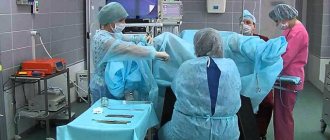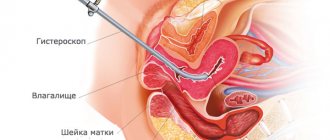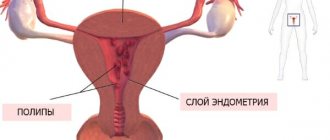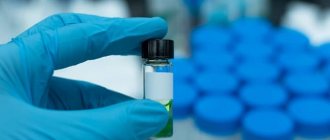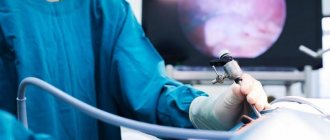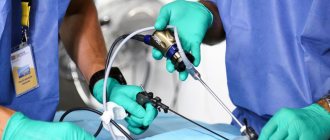How to prepare for hysteroscopy
Hysteroscopy is intended to detect and eliminate pathological changes in the endometrium of the uterus, and involves penetration into the organ cavity through the cervical canal. Since it is almost impossible to avoid injury to the membranes lining the uterus, it is important to avoid infections in the wounds, as well as to prevent bleeding.
This is precisely what recommendations on how to prepare for hysteroscopy are intended for.
What a woman needs to do before diagnostic or therapeutic hysteroscopy:
- Get tested for all kinds of infections, including genital infections. This step is necessary to prevent the occurrence of infectious complications. Laboratory tests can reveal various diseases associated with an imbalance of vaginal microflora (vaginosis), STIs, and inflammatory processes, which are contraindications for manipulation.
- Check the blood for clotting to eliminate the risk of uncontrolled uterine bleeding. Perhaps drug therapy will be prescribed as a preparation.
- Consult with specialized specialists if you have chronic diseases, including pathologies of the heart, lungs, urinary system and gastrointestinal tract. If the underlying disease requires constant use of medications, it may be necessary to change their dosage or completely eliminate their use on the eve of the procedure.
- Eat according to a special plan on the eve of the intervention so that intestinal activity does not interfere with research and therapeutic procedures.
The most difficult preparation is for hysteroresectoscopy, a procedure during which tumors in the uterus will be removed. Since it requires the use of general anesthesia, which affects the entire body, you will need to undergo a detailed study with ECG and fluorography. To conduct office hysteroscopy, which differs from others in the absence of general anesthesia, a detailed detailed medical examination, as a rule, is not needed.
Hysteroscopy method
The hysteroscope is a new generation optical medical instrument for visual diagnosis of the uterus. The tool is a rectangular body with a hose system for supplying gaseous substances and liquids. The hysteroscope is equipped with a video camera and lighting, as well as a channel for introducing special medical devices - forceps, scissors, etc.
Using a hysteroscope, you can not only examine the uterine cavity, but also carry out the necessary surgical or cleansing procedures - remove polyps and neoplasms, remove a piece of tissue for biopsy. The hysteroscope provides a general and panoramic view with magnified images on the monitor. Magnifying the image allows you to examine the mucosa at the cellular level, determining the degree of change in pathological areas.
Note! Hysteroscopy combines a diagnostic method with the possibility of surgical intervention.
Hysteroscopy of the uterus is performed both as part of the IVF program and as a method of monitoring treatment results. A distinctive feature of hysteroscopy from abdominal operations is the possibility of performing surgical intervention under the visual supervision of a doctor without the use of a scalpel. The operation is performed in a gynecological chair under intravenous anesthesia with an individual selection of analgesics. In case of contraindications to the use of intravenous anesthesia, mask or other anesthesia is used. The examination is not performed without anesthesia.
Under general anesthesia, the uterine cavity is dilated with a gaseous/liquid substance for better visual inspection. If foreign bodies (remnants of the spiral) and polyps are detected, neoplasms or objects are immediately removed using forceps or clamps. However, if a comprehensive examination is not expected, hysteroscopy is performed not under general, but under local anesthesia.
Necessary tests
Laboratory examination of patients before hysteroscopy is considered mandatory for all types of procedures. There are a number of tests that must be taken:
- general clinical urine and blood tests are required according to indications;
- biochemical blood tests and coagulation tests are necessary when planning therapeutic procedures within the framework of hysteroscopy, as well as to establish the overall picture of endometriosis, infertility and other gynecological diseases;
- venous blood tests for HIV, syphilis and other sexually transmitted infections;
- microscopy of discharge from the vagina and cervical canal to determine the flora of the genital tract and identify hidden infections or vaginosis.
If hysteroscopy is planned under anesthesia, the patient will have to undergo an ECG and also consult with a therapist.
Important! Almost all tests are valid for 2 weeks, and the results become known after 1-7 days, so a woman should take them approximately 10 days before the scheduled procedure.
How to do a hysteroscopy under the compulsory medical insurance policy
Indications are required for hysteroscopy. Therefore, the first step is to obtain a definitive diagnosis. To determine indications and contraindications, a woman must undergo an examination.
Related article: Dental services under the compulsory medical insurance policy in 2019
After diagnosis, the woman receives a referral for hysteroscopy. Together with him, she will need a passport, SNILS and a compulsory medical insurance policy. These documents are required.
The patient is put on the waiting list, and as soon as the turn comes, the woman will be notified.
What not to eat before hysteroscopy
An important part of preparing for hysteroscopy of the uterus is following a slag-free diet. It helps empty the intestines of food debris and solid contents. Such measures are necessary to ensure that intestinal loops do not compress the uterus during examinations and therapeutic procedures.
The list of what not to eat before surgery includes:
- legumes;
- all types of cabbage;
- cereals with a high content of indigestible particles;
- dark varieties of bread and bread with bran and whole grains;
- marinades, pickles, smoked meats, sausages and semi-finished products.
The list of prohibited products also includes coffee, alcohol and energy drinks. These products provoke an increase in blood pressure and also reduce blood clotting. Therefore, it is necessary to prepare very carefully for polyps, endometriosis and fibroids that are planned to be removed, avoiding their presence on the menu.
Advice! It is advisable for the patient to eat boiled, stewed, baked dishes in their own juice. Fried foods should be excluded from the menu a few days before surgery.
Indications for surgery
In what cases does a gynecologist refer for hysteroscopy? The operation is necessary when:
- endometrial pathology;
- the presence of neoplasms - cysts, fibroids, polyps;
- adhesive formations;
- tumors of a malignant nature;
- termination of pregnancy;
- removal of an ingrown intrauterine device;
- collection of biomaterial for biopsy;
- persistent infertility or miscarriages.
The examination is carried out to clarify the location of the intrauterine device, to identify the causes of unsuccessful IVF, after intracavitary operations, in case of irregularities in the monthly cycle, in preparation for pregnancy, after difficult pregnancies with complications.
Contraindications to hysteroscopy:
- inflammatory processes of the external genitalia;
- low levels of vaginal smear purity;
- severe diseases of other internal organs;
- heavy uterine bleeding;
- cervical obstruction;
- perforation of the uterine body;
- the course of pregnancy;
- cervical cancer.
Hysteroscopy can be performed as a routine diagnosis, emergency or urgent operation. In the last two cases, preparatory procedures are reduced to a minimum. How to prepare for a planned operation, what tests are needed for hysteroscopy?
Is it possible to use suppositories before hysteroscopy?
Vaginal suppositories are used primarily for local therapy and have an anti-inflammatory or antiseptic effect. Their use before hysteroscopy is not prohibited, but the choice of drugs must be treated with extreme caution. It is advisable to use products approved or recommended by the gynecologist.
Important! Suppositories are mandatory if an imbalance in the vaginal microflora was identified during the preliminary examination.
Hormonal suppositories and medications that contain hormones and act in the same way as intrauterine contraceptives should be stopped at least a week before surgery. The use of any suppositories on the day of the procedure is undesirable. In some cases, it is advised to stop using them the day before the planned hysteroscopy.
Possible contraindications
Experts note several basic disorders in which any surgical intervention is highly undesirable. Main contraindications:
- inflammatory or infectious diseases (including various acute respiratory viral infections and acute respiratory infections);
- pathologies of cardiac activity;
- severe disturbances in the functioning of the liver and kidneys;
- ailments of a destructive nature affecting the internal genital organs or ureter;
- the presence of tumors on the surface of the cervix;
- heavy bleeding.
Contraindications include the presence of tumor growths, both benign and malignant, since any mechanical damage to the tumor leads to extremely unfavorable consequences in the form of bleeding or rapid growth. It is prohibited to perform surgical intervention against their background.
Bowel cleansing before hysteroscopy
Complete bowel cleansing is performed by patients at home or in the hospital, depending on the type of procedure. You can prepare for office hysteroscopy at home, but the procedure with elements of surgical intervention requires short-term hospitalization, and therefore cleansing is carried out in a hospital setting.
To completely empty the intestines of contents, you can use a laxative (Fortrans, Lavacol). They begin to be taken the evening before the procedure according to the instructions. In the morning, 2-3 hours before the start of hysteroscopy, you can use a microenema, for example, Microlax.
If the patient is intolerant to the active ingredients of microenemas or laxatives, use a regular cleansing enema, but provided that the woman does not have signs of intestinal obstruction. It is placed the night before and, if necessary, repeated early in the morning on the day of hysteroscopy.
Hysteroscopy of the uterus: what is it and when is it prescribed?
Hysteroscopy is a procedure that involves inserting a special device with a micro-camera and a light source into the woman’s uterine cavity. Most often it is prescribed for the following purposes:
- diagnostics. If a woman cannot get pregnant for a long time, she has problems with menstruation (too long, infrequent, or there is discharge in the middle of the cycle), and ultrasound does not make it possible to establish the exact cause of these conditions. This is when hysteroscopy is prescribed.
- treatment. If a woman has polyps (whether they are growths of the mucous membrane or placental ones left after childbirth) or synechiae (fusion of the uterine cavity), then in this case hysteroscopy is also prescribed.
As you can see, after examination in the clinic , hysteroscopy can be prescribed as a diagnostic method to identify any disease, and to accompany surgical intervention. In the first case, a scraping of the mucous membrane is taken and subsequently examined to identify the causes of the disease and make an accurate diagnosis, in the second case, pathological formations are removed.
Is it necessary to shave the intimate area before hysteroscopy?
Another important point that is done before hysteroscopy is the removal of hair in the perineum and pubic area. Even with careful hygiene of the external genitalia, bacteria (including opportunistic E. coli) can remain on the hair, so the intimate area must be shaved or epilated.
It is necessary to decide individually whether it is necessary to shave completely before the manipulation (perineum, perianal area and pubis) or remove hair only in the lower part of the labia.
Recommendations after diagnostic hysteroscopy
For 2-3 days after the procedure, moderate nagging pain in the lower abdomen and moderate bleeding may persist. It is possible to increase body temperature to 37.0 - 37.2 degrees. To minimize the risk of complications, try to follow the recommendations of the gynecologist.
- If an antibiotic was prescribed, it should be continued for 5 days.
- If necessary, use painkillers and antispasmodics. The frequency of administration depends on the intensity of pain, but should not exceed that indicated in the instructions for the drug.
- Use only sanitary pads; tampons interfere with the normal flow of blood, which contributes to the development of an infectious process.
- Avoid sexual activity, physical activity, and thermal procedures for up to 10 days, until the bleeding stops. Change gaskets as needed.
- Take a shower. Avoid bathing, swimming in pools and ponds for the same period.
- Toilet the external genitalia with warm water as needed, at least twice a day.
- Monitor body temperature, the nature and amount of discharge from the genital tract, and timely emptying of the intestines and bladder.
If your body temperature rises above 37.5°C, acute pain in the lower abdomen appears, a change in the nature of discharge from the genital tract, or a deterioration in your general health, you should immediately contact your doctor or an ambulance!
After 10 days, you should make an appointment with your doctor for consultation on the results of histological examination!
READ SUMMARY
Hysteroscopy in our clinic is performed by:
What to take with you to hysteroscopy
When performing an office hysteroscopy, a woman will not need any personal items, except for a loose shirt, which she will wear during the operation. You are also allowed to bring a robe with you for this procedure. In addition, you should have a sanitary pad with you, since after hysteroscopy some spotting appears.
When undergoing hysteroresectoscopy, the woman is in a hospital, so for a comfortable stay there she will need much more things. The list of what you need to take to the department includes:
- a cotton shirt, and if preliminary hospitalization is necessary, then two;
- bathrobe and slippers;
- personal hygiene products;
- several sanitary pads.
In addition, it is important not to forget at home the medications that your doctor has prescribed to take regularly. It will not be possible to take them before hysteroscopy with anesthesia, but after the patient comes to her senses, you should take the pills as quickly as possible.
Possible complications due to improper preparation
Hysteroscopy with proper preparation takes place without negative consequences. Since this intervention still entails injury to the endometrium, both scanty bleeding and fairly heavy bleeding reminiscent of menstruation can be observed. They are not a complication, but require monitoring by the patient.
As for complications associated with violations of recommendations for preparing for surgery, doctors most often record:
- Incomplete curettage of the uterine cavity or excessive trauma to its walls due to intestinal loops filled with feces or gases interfering with the procedure. This is a consequence of non-compliance with the diet and poor bowel cleansing. The situation can even be complicated by perforation of the organ.
- Infection of the uterus with Escherichia coli or Staphylococcus aureus. Most often, these pathogenic microorganisms enter the genital tract from hair in the perianal area.
- Severe nausea and vomiting after hysteroscopy under general anesthesia. The patient may experience such symptoms if she does not follow the diet, for example, if she ate or drank water on the eve of surgery.
In rare cases, patients do not develop significant symptoms immediately after hysteroscopy, even if the preparation was carried out incorrectly or the doctor's recommendations were completely ignored. In this case, it is also impossible to say that preparation does not play a role. According to statistics, more than 30% of women later face the problem of chronic inflammation of the uterus and appendages, which arose against the background of latent infections.
Preparation for the procedure
The successful completion of the procedure depends not only on the positive results of tests and examinations, but also requires some preparation for the operation.
- Cleansing enema. For this purpose, before the procedure, a regular enema is used to cleanse the intestines. Complete emptying of the bladder is also recommended.
- Maintain personal hygiene. Immediately before the procedure, it is recommended to take a hygienic shower and get rid of hair in the genital area.
- Since hysteroscopy of the uterus involves the use of anesthesia, you should completely abstain from eating 8 hours before the procedure and from drinking 2 hours before the procedure.
It is extremely important to consult with a specialist before surgery regarding the presence of any allergic reactions.
You should definitely tell your doctor if you took antibiotics or other medications a few days before the hysteroscopy, since some combinations of drugs can cause an unusual reaction in the body.
